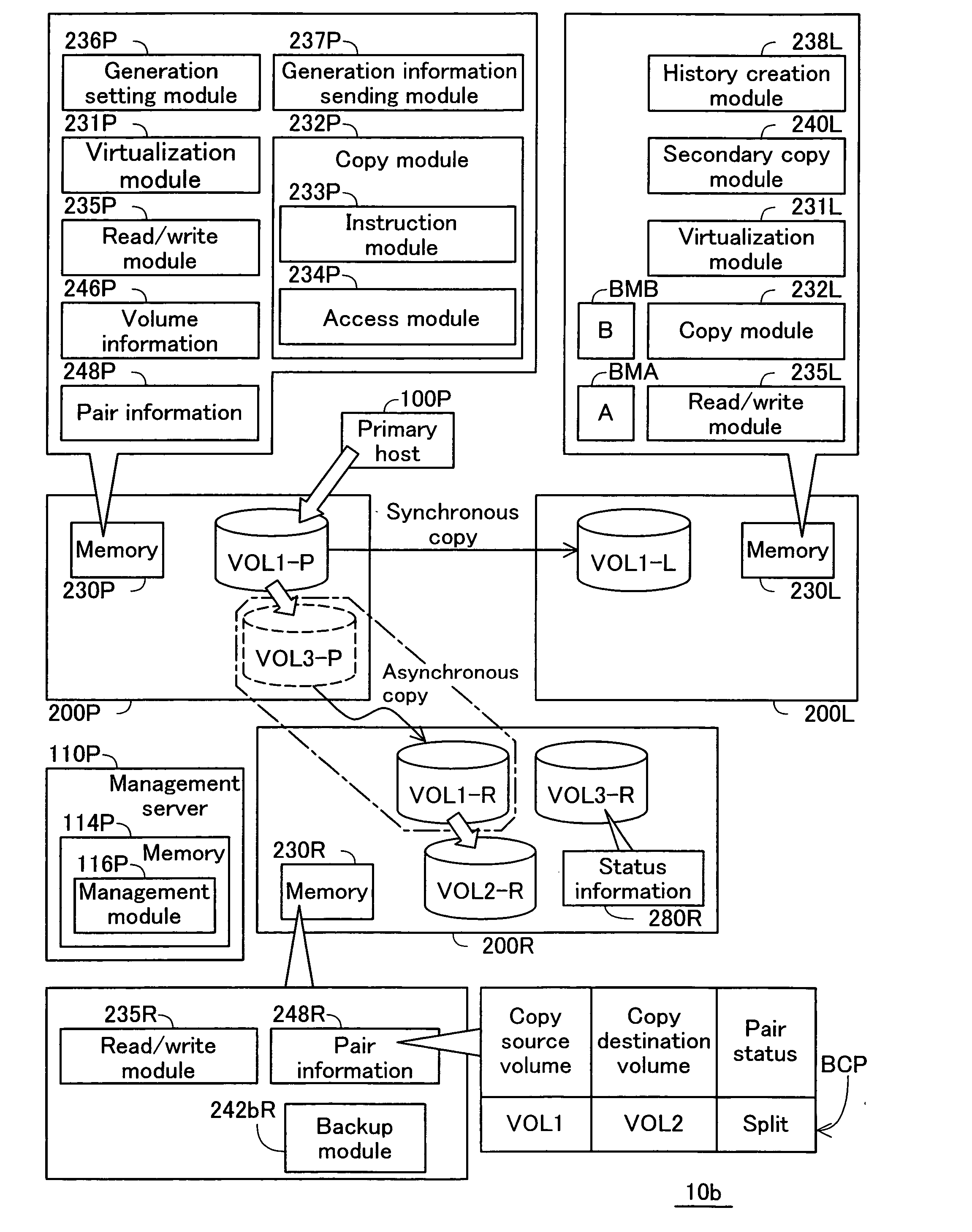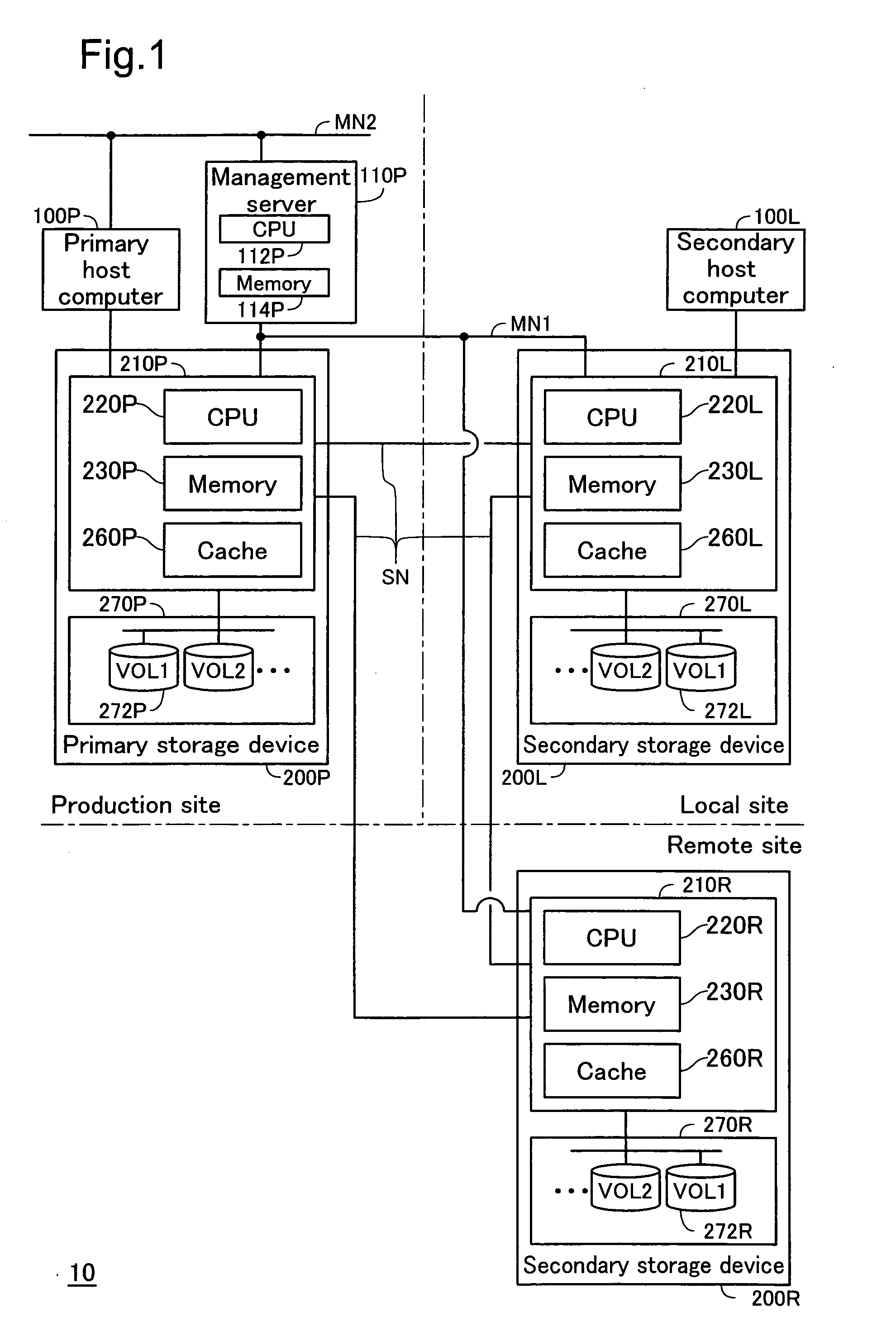Storage system for copying data and storing in a plurality of storage devices
a storage system and data technology, applied in error detection/correction, program control, instruments, etc., can solve the problems of insufficient study for improving convenience when using a plurality of storage devices, and the user's setting in many cases requires a great deal of effort, so as to reduce the effort of users and improve convenience.
- Summary
- Abstract
- Description
- Claims
- Application Information
AI Technical Summary
Benefits of technology
Problems solved by technology
Method used
Image
Examples
first embodiment
A. First Embodiment
A1. Device Constitution
[0072]FIG. 1 is an explanatory drawing showing the hardware constitution of the data processing system as an embodiment of the present invention. This data processing system 10 comprises two host computers 100 (100P, 100L), three storage devices 200 (200P, 200L, and 200R), and a management server 110P. Note that the overall three storage devices 200 (200P, 200L, and 200R) and the management server 110P correspond to the “storage system.”
[0073] The primary host computer 100P, the primary storage device 200P, and the management server 110P are installed at the production site for performing the data processing operation. The secondary host computer 100L and the secondary storage device 200L are installed at the local site near the production site. The secondary storage device 200R is installed at a remote site that is distant from the production site. Hereafter, the production site is also called the “primary site.”
[0074] With this specificat...
second embodiment
B. Second Embodiment
[0109]FIG. 7 is an explanatory drawing showing the constitution of the data processing system 10a of the second embodiment. The hardware constitution of the data processing system 10a is the same as that of the data processing system 10 shown in FIG. 1. However, the functional constitution of each storage device 200 is different from that of the data processing system 10 shown in FIG. 2. The difference for each storage device 200 is as follows.
(1) Difference for the Primary Storage Device 200P:
[0110] The memory 230P further stores the generation setting module 236P and the generation information sending module 237P.
(2) Difference for the Synchronous Storage Device 200L:
[0111] The memory 230L further stores the history creation module 238L, the secondary copy module 240L, the first bitmap BMA, and the second bitmap BMB.
(3) Difference for the Asynchronous Secondary Storage Device 200R:
[0112] The memory 230R further stores the history creation module 238R, ...
third embodiment
C. Third Embodiment
[0185]FIG. 26 is an explanatory drawing showing the process that the copy module 232P executes at the start of resynchronization of the asynchronous copy pair CP2 for the third embodiment. There are two differences from the second embodiment described above. The first difference is that the process at the start of this resynchronization is switched according to the presence or absence of problems with the synchronous copying. The other procedures of the writing process are the same as the example shown in FIG. 10 and FIG. 11. The second difference is that a new condition is added to the conditions for selecting the differential bitmap. The constitution of the data processing system is the same as the data processing system 10a shown in FIG. 7.
[0186] When the copy module 232P (FIG. 7) receives the resynchronization instructions from the management server 110P at step S300 (FIG. 11, step M144), a judgment is made of whether or not there is a problem with synchronou...
PUM
 Login to View More
Login to View More Abstract
Description
Claims
Application Information
 Login to View More
Login to View More - R&D
- Intellectual Property
- Life Sciences
- Materials
- Tech Scout
- Unparalleled Data Quality
- Higher Quality Content
- 60% Fewer Hallucinations
Browse by: Latest US Patents, China's latest patents, Technical Efficacy Thesaurus, Application Domain, Technology Topic, Popular Technical Reports.
© 2025 PatSnap. All rights reserved.Legal|Privacy policy|Modern Slavery Act Transparency Statement|Sitemap|About US| Contact US: help@patsnap.com



